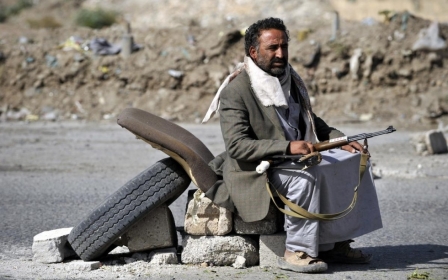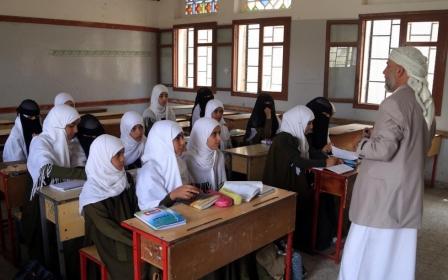The Houthis: From arms to politics

It’s been 10 years since the six-year war waged by the Yemeni state on a people in Yemen’s impoverished north, the Houthis
Since then, the Houthis, have organised themselves, multiplied in numbers and in more recent times, have taken up arms and drawn the world's attention to Yemen’s “model.”
A paramilitary army comprised of Yemeni civilians, “Ansar Allah,” a wing under the Houthi group, briefly seized control of several strategic cities throughout the country, including the capital, Sana’a.
The recent events proved that in lieu of a transitional government, neither President Abu Rabu Hadi nor the Islah political party, which dominated the transitional period with the facilitation of the Gulf Cooperation Initiative (GCC), could bring about the change needed in the country. The GCC initiative involved the transfer of power from former President Ali Saleh to Vice President Abd Rabu Mansour Hadi, in return for Saleh’s immunity from prosecution. A National Dialogue Conference (NDC) was held for 10 months and a national unity government was created, divided between the then opposition, Islah and Saleh's ruling party.
Both the GCC. and the NDC fell short of bringing about the change which so many people demanded in 2011. Thus, continued injustice, lack of security and an economic crisis inflicted by neo-liberal policies helped the Houthi movement gain ground throughout the country. "Jobs and security," Hussein al-Bukhaiti, a socialist turned Houthi activist, said remain the primary concerns of most Yemenis.
A peace agreement, brokered by UN Special Envoy to Yemen, Jamal Ben Omar, calling for economic and social reforms, was signed on 21 September, 2014, followed by a tactful speech by the Houthi leader, Abdul Malik al-Houthi, which inspired a complete rethink of what Yemen could be and look like for the masses. Despite the nationalistic speech, the movements’ agenda remains unclear.
10 years on
Today the Houthis have been transformed from a marginal group to a powerful movement. Having gained semi-regional autonomy in Northern Yemen in 2000, the Houthis govern their own communities across different regions of Saadah. With their relationship remaining tense with the state, the Houthis continually complain of being marginalised.
Beyond the struggle for political representation, the Houthis have held many non-violent solidarity and economic justice protests. They also participated in the 2011 uprising. Their rejection of economic corruption and political injustice lies at the heart of their continued local appeal.
Militarily powerful, socially popular, and politically driven, the Houthis have now changed the face of Yemeni politics. They challenged General Ali Mohsen al-Ahmar and other members of the Islah party, who were part of fighting six wars against the group with the former regime. Mohsen and other members of the al-Ahmar family are also accused by some of corruption.
These actions by the Houthis, however, were not without a heavy price. The Yemeni Health Ministry reported that the recent events have left 200 dead and over 400 wounded, Media also reported stories of housing and school takeovers.
Adel Shamsan, a 40-year old independent activist recently had his home broken into by the Houthis. “They smashed the door and then entered the house just to use it as a shooting spot. Imagine you have put your life savings into that house, are they going to compensate me?” Shamsan said.
“All that fear made me feel that they [Houthis] won't hesitate to put us in danger.” he continued.
Yet, despite the human rights violations reported, the Houthis remain popular on the local level, as was demonstrated last month.
So, what does the future of Yemen look like?
The Houthi’s may have generated people power to confront the government, but how effective they will be in bringing about real change remains a big question. There is legitimate fear from independent activists that the Houthi’s multiplying across the country will do so in a way that lacks the social and economic justice narrative that characterised what many saw to be Yemen’s most important and beautiful moments during the early 2011 uprising.
Yemen is now operating in the shadows of an ever-powerful and assertive Houthi movement. Whatever happens in the next couple months by President Abdu Rabu Hadi will be shaped by the Houthis. If President Hadi manages to address the immediate needs of the people, the support of the Houthis will rise even higher within Yemen. If he doesn’t, the Houthis have left themselves, and Yemen, in a very dangerous position. Replacing power from Islah to the Houthis renders the Houthis’ resistance ineffective. Either way, the chess game in Yemen continues, only now revolving more strongly around the Houthis.
As a political movement, the Houthis have managed to light the torch of anger blazing within Yemen. But will they advance as far as they hope?
There is grave danger to consider if the Houthis cling to power; this can also lead to an alternate form of authoritarianism, something they claim to oppose. As the GCC. initiative did for Yemenis in 2011, so could the new UN-brokered peace agreement if international and regional involvement takes precedent over local voices. Lastly, if the Houthis do not build on all peoples’ experiences and if they are not willing to question their own ideals and strategies, another popular uprising, by another group, is sure to be underway.
The year ahead is going to be arduous for Yemenis. As they attempt to renew their struggle for social, political and economic justice, the “new government” will need the people’s scrutiny to deliver. Questions and criticism are part and parcel of this. The instability of Yemen and the continuous hope for real change means that the re-emergence of a new Yemen that works for all remains a possibility, even if it seems far-fetched at the moment. Small, often ignored struggles, like the muhamasheen or the southern movement can begin connecting with other struggles, like the Tehama movement, to shift the political sphere towards building a democratic Yemen.
Yemen has a long way to go. But one thing is certain: the key to renewing Yemen’s 2011 uprising will be in the ability of all people to build on each other’s collective struggles and work together towards liberation and justice for all.
- Rooj Alwazir is a Yemeni-American documentary photographer and co-founder of SupportYemen media collective based in Sana'a.
The views expressed in this article belong to the author and do not necessarily reflect the editorial policy of Middle East Eye.
Photo: Armed Yemeni Shiite Huthi rebels sit at the Al-Iman Islamic University which they captured in the Yemeni capital, Sanaa on 29 September (AFP)
New MEE newsletter: Jerusalem Dispatch
Sign up to get the latest insights and analysis on Israel-Palestine, alongside Turkey Unpacked and other MEE newsletters
Middle East Eye delivers independent and unrivalled coverage and analysis of the Middle East, North Africa and beyond. To learn more about republishing this content and the associated fees, please fill out this form. More about MEE can be found here.





